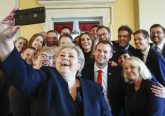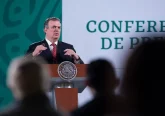Only three years ago, pundits and political scientists saw the 2008 American presidential election as the beginning of a new era in Washington: the rise of President Obama and a strong Democratic majority in both houses of Congress meant that after eight years away from Pennsylvania Avenue, liberals could again implement political programmes and reforms free from Republican meddling. It provided an opportunity for a fresh progressive platform and created a new mood unlike any since the early years of the Clinton administration, or maybe since the dawn of the Great Society in the 1960s.
The conservatives, meanwhile, were in despair; heavy losses darkened the mood and they saw Obama as a charismatic leader who would be difficult to beat, even in 2012. William Kristol (the Sarah Palin queen-maker), writing in the New York Times six days after the election, thought even Obama’s promise to buy his children a new puppy was a stroke of political genius, pulling on every dog-owner’s emotional heartstrings. What’s not to love? Overcoming him looked daunting.
But were the early reactions correct? Those who predicted a profound shift in the ideological landscape might now look back on the 2008 elections as a damp squib. Today’s frustrated liberal wing of the Democratic Party most certainly does and perhaps conservatives had less to fear.
A new book edited by Oxford’s Gillian Peele, a Fellow and Tutor in Politics at Lady Margaret Hall, and Joel Aberbach, a political scientist at UCLA, unpacks the 2008 moment for American conservatism. With chapters by a range of contributors from the United States and the UK, Crisis of Conservatism?: The Republican Party, the Conservative Movement and American Politics After Bush, published by Oxford University Press, covers topics from the future of the Christian Right to conservatism and the courts. Did the seemingly tight-knit group of what become known as the conservative movement during the Reagan through Bush years finally break up? What would be their legacy?
To learn more about the book, Politics in Spires sat down with Gillian Peele over a strong cappuccino at Lady Margaret Hall.
Thanks for speaking with Politics in Spires. Tell us a bit about the book and why you think it is an important addition to the conversation on the influence of conservative ideology on American politics.
Our book builds on recent work by Joel [Aberbach] and by me on the evolution of the right in America. I have worked on this topic for some time- indeed I feel I was in at the beginning of the movement’s new form at the start of the Reagan presidency. (see my 1984 book, Revival and Reaction, for which I interviewed many key players in all parts of the movement and the Republican Party). In a sense the story has come full circle so that with the Bush presidency of 2001-2009 we find fissures in the movement opening up, cracks which had been concealed during those earlier days. (e.g. libertarians at Cato v. social conservatives and small v large government conservatives). We held a conference bringing together representatives of the different parts of the conservative coalition as well as academics and critics of conservatism to try to analyse why the divisions had become so marked and to explore the implications for the future course of politics on the American right.
Why do you call it a movement? Why not a conservative tradition?
It is in my view an essential, indeed crucial, part of the story of American conservatism that it became a powerful organizational force in the late 1970s developing an infrastructure where none was before. This meant putting in place media outlets, training journalists, developing a stronger presence on the campus and in the professions, establishing or rejuvenating think tanks and policy institutes and of course raising money. A conservative tradition may be intellectually inspiring but cannot achieve results; the conservative mobilization after 1964 which accelerated in the 1970s and was further boosted by the Reagan victory produced a movement which reinforced, though was sometimes at odds with, the Republican Party and was able to elect candidates and project itself in the political arena.
Some may question the use of the word ‘crisis’. Republicans were certainly in retreat in 2008; but in watching the fights over health care reform and public spending it would seem that conservatism is alive and well and it is liberalism that is in crisis.
The Bush presidency saw the conservative coalition and the Republican Party becoming increasingly restless—about federal expansion and big-government, about anti-libertarian policies and sentiments and about the Iraq war and the aggressive style of the Bush administration. The coalition that had held together threatened to and perhaps did crack after about 2006, although opposition to Obama on the right and the new force of Tea Party activists have caused an apparent resurgence of the right since 2009.
It seems the resurgence has more to do with the limited government and isolationist elements of American conservatism, a group that Walter Russell Mead labels as Jeffersonian, and which is more sceptical of the grand foreign policy visions supported by the Bush administration. In the book you have an essay by Trevor B. McCrisken about the Future of Republican Party foreign policy, does it (and your own opinion) see a return to renewed isolationism?
No. Trevor and Tim Lynch see a lot of continuity between Bush and Obama although there are of course differences. I think that with Obama there has been obviously a shift away from the kind of aggressive philosophically based approach of the Bush years to a liberal pragmatic one; and of course that is also opposed to what would be called conservative pragmatic approach, what Trevor might label “back to basics”. Obviously the Obama administration is more attuned to and sensitive to the international environment and international organization. So that is a very different stance. Republicans might not share that and identify their “basics” differently. But isolationism? No – I do not really think that is possible for either Republicans or Democrats.
What about conservatives in Congress?
Well Republicans in Congress have always been more prone to reject international entanglement than the presidential wing of their party. I think neo-isolationism, or as I would prefer to call it a kind of America First neo-nationalism, is the default position of the United States, a powerful magnet for conservative critics of failures abroad. Building and sustaining a coordinated international stance for the United States at home and abroad is difficult.
Peter Beinart, former editor of The New Republic, recently claimed that “neoconservatism” is no longer an ideological or political force given the Iraq debacle and renewed distaste for expensive foreign intervention after the financial crisis. Do you see a future for the neocons in the GOP?
I don’t think neoconsrvatism is dead, although its obituary has been written by some authors. I think the approach of the neoconservatives, especially those with a pragmatic approach to that philosophy, is likely to continue.. The second generation of neocons were perhaps more ambitious than their forbears and I think some of the wilder claims of neoconservatism are not going to be seen again. But if you see neoconservatism as I do as a species of conservatism which can adapt and adjust to the needs of the time and a changing political agenda, its always going to have a role on the right. Its pragmatism is key to its survival. That said it can be anything, everything or nothing; labeling something as an enduring neoconservative position is always going to be problematic.
You can order Gillian’s book via Blackwells or Amazon.








No Comment